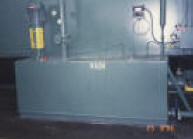|
|
香港噴塗機械工業有限公司 |
|
HONG KONG SPRAYING AND MACHINERY INDUSTRIAL CO. LTD.
|
| PRODUCT |
|
|
|
|
|
|
|
|
|
|
|
|
|
|
|
|
|
|
|
|
|
|
| HONG KONG OFFICE |
| Address: No 7-8, 11/F Block A, Vigor Industrial Building, 14-20 Cheung Tat Road, Tsing Yi |
| Tel: 24317981 |
| Fax: 24320126 |
| E-mail: sales@hkspraying.com.hk |
| PRODUCT | CONTACT | 中文 |
| Pretreatment |
Reason for pretreatment
-------------------------------------------------------------------------
|
|
Pretreatment is important for spray quality
control - no grease, no rust and no
scratches on objects
Objects with pretreatment can have 1. greater paint adhesion2. higher paint corrosion-resistance 3. greater chemical resistance
|
|
Pretreatment
methods
-------------------------------------------------------------------------
| Plastics | ||
|
|
Annealing Plastics is easy to transform during curing, so pre-heating plastics to its pre-transformation stage is required to reduce its internal stress
Organic solvent degreasing Benzene, xylene, trichloroethylene is used for degreasing. Rinsing afterwards is necessary to reduce oil film deposited during degreasing
De-ionizing Plastics is a bad conductor which is easy to attract electrostatics, de-ionizing gun is necessary to remove electrostatics after pretreatment
Surface improvement to make plastics surface be coarser and more chemical resistant for better paint adhesion by: 1. sand blasting 2. UV curing 3. flame oxidation 4. solvent etching
Drying Drying is necessary for corrosion resistance after pretreatment
|
|
|
|
||
| Steel | ||
|
Degreasing: 1. Organic solvent degreasing Benzene, xylene, trichloroethylene is used for degreasing. Rinsing is necessary afterwards to reduce oil film deposited during degreasing
2. Alkaline degreasing to remove animal or plant oil by the action of alkaline solution and saponifiable oil surfactant/Emulsifier is required to remove saponifiable oil (lubricant, anti-rust paint) as alkaline solution is not effective to remove sponifiable oil
3. Ultrasoun d degreasingto clean object surface by impact wave of ultrasound is suitable for objects with difficult edges (e.g. eye frames)
Derusting 1. mechanical derusting/sand blasting use sand particles to derust steel by centrifugal action of sands
2. acidic derusting use hydrochloric acid, sulfuric acid, nitric acid or hydrofluoric acid to remove rust and oxides on objects. Etching relieving agent is recommended to avoid over-etching.
Deoxidizing is required before phosphating to avoid over-etching during acidic derusting
Phosphating to improve paint adhesion & corrosion resistance by creating a conversion coating on the object
Phosphating can be divided into 1. Iron phosphatinguse ferric salt phosphates to make a thin phosphate coating on iron, low phosphating temperature is required suitable for objects with high exterior requirement but low corrosion resistance (e.g. electro-plating, electrostatic painting)
2. Zinc phosphatinguse zinc salt phosphates to make a thick phosphate coating on iron, high phosphating temperature is required suitable for objects of low exterior requirement but high corrosion resistance (e.g. derusting objects, stretching objects)
Drying Drying is necessary for corrosion resistance after phosphating
|
|
|
|
|
||
|
|
||
|
|
||
| Aluminum alloy | ||
|
Degreasing: 1. Organic solvent degreasing Benzene, xylene, trichloroethylene is used for degreasing. Rinsing is necessary afterwards to reduce the oil film deposited during degreasing
2. Alkaline degreasing to remove animal or plant oil by the action of alkaline solution and saponifiable oil surfactant/Emulsifier is required to remove saponifiable oil (lubricant, anti-rust paint) as alkaline solution is not effective to remove sponifiable oil
3. Ultrasoun d degreasingto clean object surface by impact wave of ultrasound
is suitable for objects with hard to reach edges (e.g. eye frames)
Deoxidizing is required before phosphating to avoid over-etching during acidic derustingDrying Drying is necessary for corrosion resistance after phosphating or cleansing
|
|
|
|
|
||
Choosing your pretreatment line
-------------------------------------------------------------------------
| Spraying Pretreatment Line | |
|
1. cleaning method to pump out cleansing detergent by spray nozzles
2. Suitable for alkaline cleansing, surfactant cleansing 3. Advantages degreasing temperature can be lowered to below 50℃ and faster degreasing time
4. Disadvantages only suitable for simple objects, not suitable for objects with difficult edges
|
|
|
|
|
|
|
|
|
|
|
|
|
|
|
|
|
|
|
|
||
|
|
|
|
| Immersion Pretreatment Line | |
|
1. Immersion tank a. 2 types of immersion tanks i. 'ship' tank: overhead conveyors to put objects into immersion tanks ii. rectangular tank: reciprocators or chain hoists to put objects into immersion tanks b. made of i. degreasing tank: steel ii. derusting tank: fibre reinforced plastics or stainless steel iii. phosphating tank: stainless steel with insulation layer to reduce heat loss c. heating elements i. direct heating: boil water with heating elements ii. indirect heating: heat up tank water with heat exchangers, suitable for phosphating tank to reduce heat transfer loss if phosphates are deposited in tank 2. Suitable for Alkaline cleansing, surfactant cleansing or ultrasound cleansing
3. Advantages can cleanse complex or objects with difficult to reach edges
4. Disadvantages need to boil water up to 60℃ with agitation larger workshop longer pretreatment time
|
|
|
|
|
|
|
|
|
|
|
|
|
|
|
||
DRYING OVEN
-------------------------------------------------------------------------
|
|
Drying is necessary for corrosion resistance after phosphating or cleansing Drying time is important for corrosion resistance
|
|
|
|
|
|
|
|
|
|
|
|
|






